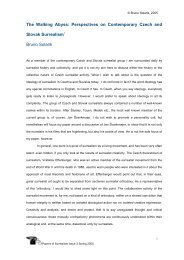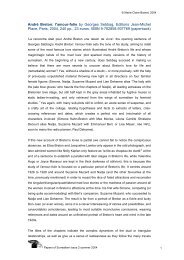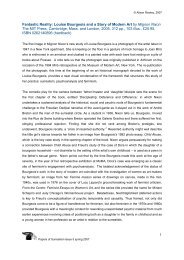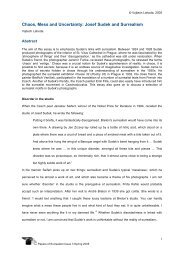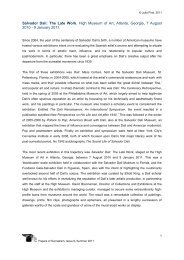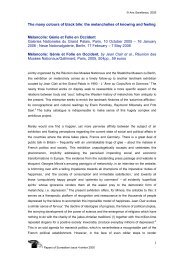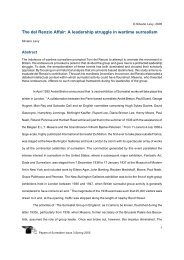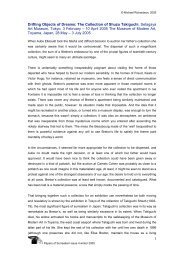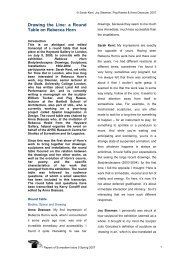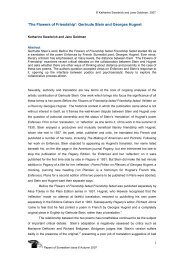From the Walls of Factories to the Poetry of the Street: Inscriptions ...
From the Walls of Factories to the Poetry of the Street: Inscriptions ...
From the Walls of Factories to the Poetry of the Street: Inscriptions ...
Create successful ePaper yourself
Turn your PDF publications into a flip-book with our unique Google optimized e-Paper software.
© Caroline Levitt, 2011<br />
26 Susan Harrow, „The Au<strong>to</strong>biographical and <strong>the</strong> Real in Apollinaire‟s War <strong>Poetry</strong>,‟ The Modern<br />
Language Review, Vol. 97, No. 4, Oc<strong>to</strong>ber 2002, 827-8.<br />
27 Richard Anacréon was a bookseller and art collec<strong>to</strong>r. See, Elisabeth Noël Le Con<strong>to</strong>ur, Le Merle<br />
blanc de la Monaco du nord.<br />
28 Roger Little, Guillaume Apollinaire, The Athlone Press, London, 1976, 38.<br />
29 The manuscript for Le Poète assassiné is held in <strong>the</strong> Biblio<strong>the</strong>que littéraire Jacques Doucet (code<br />
1034 B-V-5). For work on Apollinaire‟s drawings, marginal and o<strong>the</strong>rwise, see Jean Burgos, ed.,<br />
Guillaume Apollinaire 22: Apollinaire, le dessin et les traces, Caen, La Revue des lettres modernes/<br />
Minard, 2007: Claude Debon and Peter Read, Les Dessins de Guillaume Apollinaire, Buchet<br />
Chastel/Les Cahiers dessinés, Paris, 2008.<br />
30 Ernst Gombrich, The Uses <strong>of</strong> Images: Studies in <strong>the</strong> Social Function <strong>of</strong> Art and Visual<br />
Communication, Phaidon, London, 1999, 213.<br />
31 Ibid., 214.<br />
32 Ibid., 225.<br />
33 Brassaï, „Poème sur les graffiti,‟ in Graffiti (1961), Flammarion, Paris, 1993, 151 („Graver son nom /<br />
son amour / une date/ sur le mur d‟un edifice, / ce vandalisme ne s‟expliquerait pas par le seul besoin<br />
/ de destruction. / J‟y vois plutôt l‟instinct de survie / de <strong>to</strong>us ceux qui ne peuvent dresser/ pyramides<br />
et cathédrales/ pour laisser leurs noms à la postérité‟).<br />
34 Susan Harrow, „The Au<strong>to</strong>biographical and <strong>the</strong> Real in Apollinaire‟s War <strong>Poetry</strong>,‟ 828.<br />
35 Julian Stallabrass, Gargantua: Manufactured Mass Culture, Verso, London and New York, 1996,<br />
136.<br />
36 Guillaume Apollinaire, Le Flâneur des deux rives, 5 („une plaque de marbre marquant que là se<br />
trouvait autrefois la limite des seigneuries de Passy et d‟Auteuil‟).<br />
37 Ibid., 6 („Il n‟y a plus que très peu de lanternes anciennes … on peut regretter que la ville n‟ait pas<br />
conservé, dans son dépôt, au lieu de les vendre, un specimen au moins de chaque appareil<br />
d‟éclairage‟).<br />
38 Guillaume Apollinaire, Les peintres cubistes (1913), trans. Peter Read, University <strong>of</strong> California<br />
Press, Berkeley, 2004, 80.<br />
39 Guillaume Apollinaire, „Le Poète assassiné‟ (1916), in Œuvres en prose complètes, vol. 1, 301 („une<br />
pr<strong>of</strong>onde statue en rien, comme la poésie et comme la gloire‟). As Peter Read has pointed out in his<br />
Picasso and Apollinaire, Picasso‟s wire maquettes, studies for a sculpture <strong>to</strong> be placed on<br />
Apollinaire‟s <strong>to</strong>mb but rejected as „<strong>to</strong>o modern‟ by <strong>the</strong> committee in charge <strong>of</strong> his commemoration,<br />
perhaps came closest <strong>to</strong> realising <strong>the</strong> statue that Apollinaire describes. See Peter Read, Picasso and<br />
Apollinaire, 177.<br />
40 André Bre<strong>to</strong>n, Nadja, 663.<br />
41 Ibid., 653. See also Simon Baker, Surrealism and <strong>the</strong> French Revolution, PhD <strong>the</strong>sis, University<br />
College London, 2002.<br />
42 The pho<strong>to</strong> is attributed <strong>to</strong> Jacques-André Boiffard in <strong>the</strong> 1963 revised edition <strong>of</strong> Nadja. For <strong>the</strong><br />
pho<strong>to</strong>, see Bre<strong>to</strong>n, Nadja, 654.<br />
43 Ibid., 708 („<strong>to</strong>ut s‟affaiblit, <strong>to</strong>ut disparaît. De nous il faut que quelque chose reste‟).<br />
Papers <strong>of</strong> Surrealism, Issue 9, Summer 2011 22





